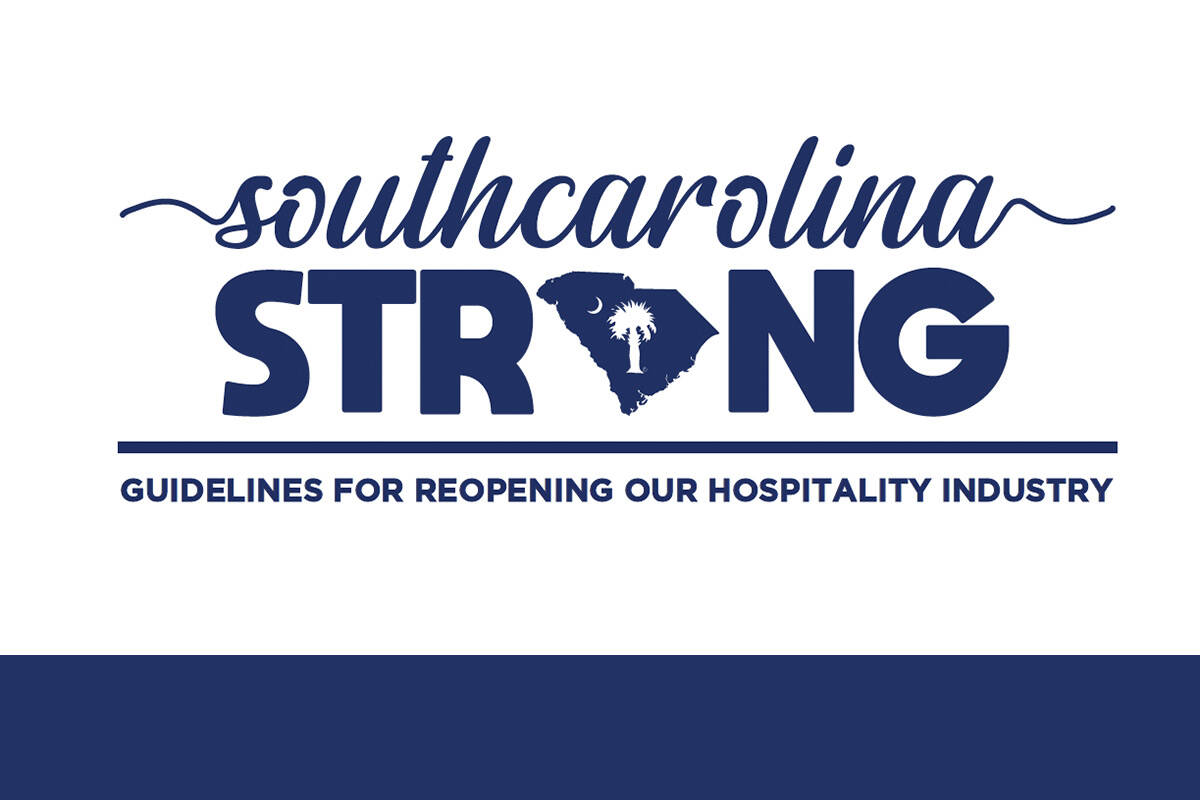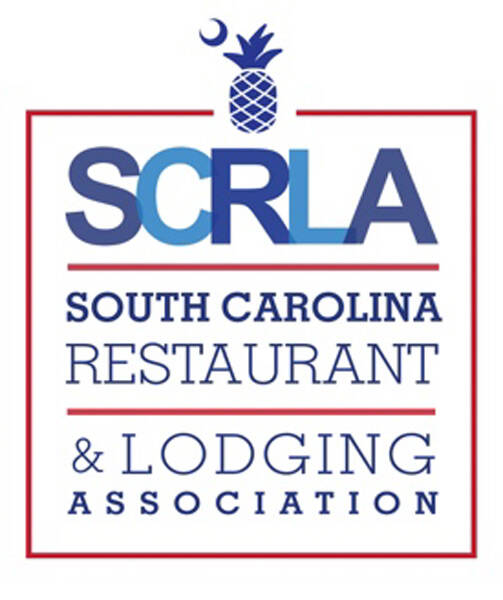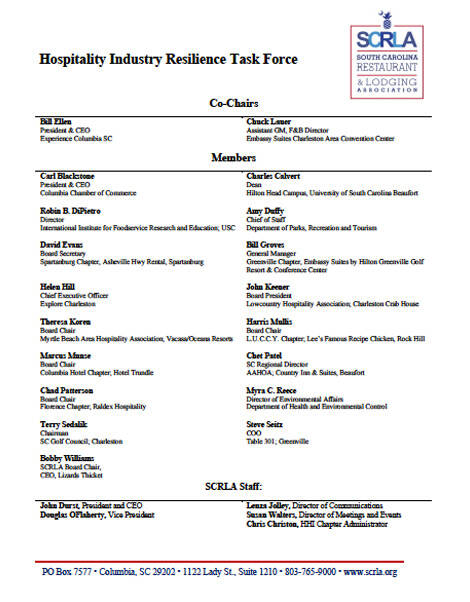
South Carolina Strong: Guidelines for Reopening Our Hospitality Industry

South Carolina – Opening Hotels and Event Venues
Phase One Recommendations
The guidelines detailed in this plan are driven by three major considerations: safety, gradual and phasing in. We respectfully submit this balanced and strategic approach using best practices is the optimal approach for the state – our fellow citizens and our guests.
Full opening of hotels and Event Venues will need to allow lead time for staff to be rehired and trained, the food supply chain to be fully and normally operational, safety measures to be implemented, including providing ample time for operators to get the necessary Personal Protection Equipment (PPE) and do a deep re-clean and sanitization of the entire facility using the CDC-recommended guidelines during COVID-19 to keep staff and guests safe.
South Carolina is committed to following the protocols established by Governor McMaster regarding safe social distancing and this heightened awareness of public safety. South Carolina’s hospitality industry is waiting for the return of its guests and, in the meantime, we are preparing for the reopening by suggesting doing the following things to welcome customers:
Lobby and Common Areas
1. Entrance doors that do not open/close automatically should consider having a door attendant.
2. Arrange furniture in lobby to incorporate social distancing guidelines.
3. Touchless Hand Sanitizer stations if available. At a minimum hand sanitizer available throughout lobby reception areas, suggested areas to include but not limited to elevator landing and employee entrances, but could also include any other reception areas, entire hotel lobby areas, restaurant entrances, meeting spaces, elevator landings, pools, exercise areas and other public areas as applicable to the property.
4. Public-area cleaning frequency increased. Cleaning products and protocols shall include EPA-approved disinfectants that meet CDC requirements for use and effectiveness against viruses, bacteria and other airborne and blood-borne pathogens, including COVID-19.
5. Signage in lobbies and public areas to remind guests of social distancing protocols.
6. Frequent disinfection of all high-touch areas such as door handles, elevator buttons, handrails, telephones and remote controls.
7. Surfaces in public areas and guest rooms required to be cleaned thoroughly with hospitalgrade disinfectants.
8. One person or one family/household per elevator car. (post appropriate signage to promote this policy on each floor)
9. Signage to be posted in public areas and service areas indicating the proper way to wear, handle and dispose of masks.
10. Appointments taken for workout room to contain number of guests to ensure appropriate social distancing is maintained.
11. Fitness centers closed multiple times each day for cleaning, and a limit on the number of guests permitted allowing for appropriate social distancing.
Front Desk:
1. Plexiglass shield or similar protective barrier between front desk agent and customer.
2. Key cards to be sanitized or discarded after each use.
3. Digital key technology for check in, accessing their rooms or making special requests.
4. All guests to be asked to fill out a declaration form detailing their recent travels.
5. Reservation agents to ask guests about their health and travel and exposure to COVID-19 cases before booking a room.
6. Contactless payment processes are encouraged.
7. Self-parking options should be emphasized, where possible.
• If valet service is provided, disinfecting of contact points within the vehicle is required. In addition, van and shuttle service shall be limited, and disinfecting of contact points will be required.
8. Areas where guests or employees can gather should be shut off if possible, and if not, clearly marked for appropriate physical distancing, and where possible, encourage oneway guest flow with marked entrances and exits.
Swimming Pools:
According to the CDC, the virus that causes COVID-19 cannot be spread to people through the water in pools, hot tubs, spas, or water play areas. However, the opportunity for transmitting the virus does exist in surrounding areas. In addition to the above safe-practices, swimming pools should comply with the following additional guidelines to further minimize the potential for transmission and spread of COVID-19 in and around pools:
1. Facilities should only allow 20% of normal occupancy or 5 people (staff and visitors) per 1000 square feet of pool and deck area, whichever is less.
2. Person-to-person interaction and activities between members of separate households should be limited and social distancing of six feet between them should be practiced.
3. Commonly used surfaces such as bathrooms, doors, handrails, ladders, gates, lawn chairs, drinking water fountains, picnic tables, etc. should be cleaned and disinfected between each use by a different person, or at a minimum, once a day.
4. Hand sanitizer should be provided for use by all staff and visitors.
5. Signs and/or examples of six foot areas related to social distancing should be posted.
6. Full compliance with SC Public Swimming Pool Regulation 61-51 is always required.
7. Remove from service or regularly disinfect sharable equipment. (for example, kick boards, floats, etc.)
8. Consider lane reservations to allow family groups to use a lane or specific area of a pool.
9. Consider a phased approach to opening that brings back lane swimming and limited number participant classes before opening for general swimming.
10. Lifeguards should continue to follow universal precautions when rendering first aid of any type to patrons.
11. Follow CDC guidelines regarding cleaning and disinfecting.
Housekeeping:
1. Enhanced cleaning standards throughout the hotel, including guest rooms, meeting spaces, common areas, and back-of-house spaces.
2. Cleaning products that are EPA-approved for use against bacteria, viruses, and other pathogens, including COVID-19. (see EPA list here: undefined list-n-disinfectants-use-against-sars-cov-2)
3. Housekeeping shall not enter a guest room during a stay unless specifically requested, or approved, by the guest.
4. Room is left vacant for 24 hours after a guest checks out for deep cleaning.
5. Disinfecting wipes will be placed in each guest room.
6. Glassware, coffee cups, and multi-cup coffee makers should be removed. Single serve coffee makers can remain provided disposable cups are used.
7. Remove items from the mini bar.
8. No room service from dining or housekeeping.
9. Guest room pens, paper and guest directories may be removed and replaced with digital substitutes.
10. Linens, towels and laundry shall be washed in accordance with CDC guidelines, including washing items as appropriate in accordance with the manufacturer’s instructions.
• Where possible, launder items using the warmest permissible water setting for the items and dry items completely.
• Dirty linen shall be bagged in the guest room to eliminate excess contact while being transported to the laundry facility.
11. Extra / clean towels available upon request.
12. In the event of a presumptive case of COVID-19, the affected guest room shall be removed from service and quarantined for 96 hours. The guest room shall not be returned to service until undergoing an enhanced cleaning and disinfecting utilizing EPA approved products within CDC guidelines.
Food and Beverage:
1. All hotel operations with a DHEC Retail Food Establishment Permit are required to meet the minimum education and training standards outlined in DHEC Regulation 61-25. At least one employee with the authority to direct and control food preparation and service shall be a food protection manager who has been certified by an accredited program. Only Conference for Food Protection ANSI-certified Food Protection Manager courses meet the requirements of 2-102.20.
2. Space tables both indoors and outdoors at least six to eight feet apart, depending on chair placement to keep diners at least 6’ apart from other tables. If not possible due to built-in seating, seat tables in rotation, or block seats. Reduce seating in dining rooms to the appropriate level based on square footage and layout of the dining room. Occupancy may not exceed 50% during Restaurant Reopening Phase Two.
3. Buffets and self-service stations: Have staff dispense food from buffets (cafeteria-style) or discontinue these services to prevent customer reuse of service utensils and potential physical contamination. Attendants should wear appropriate PPE.
4. Sneeze and cough screens shall be present at all food displays and service areas.
5. Do not place plates, glassware, utensils or condiments on table. If possible, use disposable single-use products and portion control condiments.
6. In self-service seating restaurants, signage should be placed on tables/booths which are not to be occupied so that proper social distancing can be maintained.
7. Minimal items should be placed on guest tables to allow for effective disinfection in between each guest, including condiments, silverware, glassware, napkins, etc.
8. Post in a publicly prominent place in your facility and on your website your commitment to:
• Food safety
• Staff safety training
• Steps that you are taking to go above and beyond in providing safe food and a safe, enjoyable dining experience
• Customer safety
• Customer responsibility
9. Refer to the SCRLA restaurant guidelines for additional information and guidance.
Meeting and Banquet Space:
1. Maintain social distancing to keep attendees at least 6’ apart.
2. Registration areas should have markings on floor to show guests where to stand for appropriate distancing.
3. One-way entrance and exits into meeting rooms where possible.
4. No self-service beverage break stations; when applicable have multiple stations arranged so as to avoid congregating based on the number of attendees.
5. Multiple hand sanitizing stations in each room.
6. Microphones on stands or handheld should be discouraged or cleaned after each speaker if used.
7. A maximum of 6 people per 72” round. Each table needs to have at least six feet of separation from seating to seating in each direction.
8. Maximum of 10 people per 500 square feet with a maximum of 250 attendees with social distancing in place.
9. Provide signage at the registration area to inform all attendees that they should:
• Not to enter if they feel generally unwell
• Maintain a minimum of 6-foot distance
• Sneeze or cough into a cloth or tissue
• Not shake hands or engage in any unnecessary physical contact
10. Refer to Food and Beverage section for additional food service guidance and safety protocols.
Employees:
1. Masks and gloves will be made available to all hotel associates, and they should be strongly encouraged to wear masks or cloth face coverings.
2. Train all employees on how to respond swiftly to any presumed cases of COVID-19 on
property and report them to management.
3. Each staff member will have his/her temperature taken before their shift and there will be ongoing interaction with staff on their health status and the health of anyone with whom they may be in close contact (family members, roommates, etc.).
4. Well-being checks of all employees, including physical temperature checks prior to each shift.
5. Employees must stay home if they are sick or if they are instructed to quarantine as a close contact with a person diagnosed with COVID-19.
6. Employees who notice a coworker or guest exhibiting symptoms of COVID-19 shall immediately contact a manager.
7. Employees to be tested for COVID-19 prior to returning to work.
8. All employees shall receive COVID-19 safety and facility sanitation protocols training recommendations from the CDC with more comprehensive training, consistent with the CDC, for employees with frequent guest contact including Housekeeping, Food & Beverage, Public Area Department, Hotel Operations, Security, Valet/Door/Bell Services, and Maintenance/Engineering.
9. Shared tools and equipment shall be disinfected after each shift or transferred to a new employee.
Customer Safety Focus:
1. Plan ahead of time for a circumstance needed to expedite a guest’s exit from your hotel.
2. Be prepared to put guests in touch with medical resources.
3. Promote to the local community that employees are well-versed in the importance of personal health and hygiene and that they understand the critical importance of cleanliness and sanitation of the establishment.




